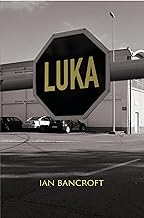Review: LUKA
This novel was recommended to me by a friend, and as it is about civil conflict situations, I bought a copy.

The author, Ian Bancroft, is a writer and former diplomat based in the former Yugoslavia for over fifteen years. He has written travel articles for various publications, and he has produced foreign policy analysis for The Guardian, Radio Free Europe, UN Global Experts and others. Ian’s first book, ‘Dragon’s teeth – tales from north Kosovo’, was published in 2020.
There are four main characters in LUKA. ‘A’ is a beautiful girl who grew up in Old Town; she has lived through a prior war. She is single and now twenty-seven. ‘L’ is a talented young painter who also lives in Old Town. ‘U’ is a long-serving police officer who never questioned the wisdom of his superiors. ‘K’ is the mother of ‘A’, and an assembly-line worker in a munitions factors. She vigorously defends her father known by the nom de guerre ‘Jinn’, as in ‘djinn’, owing to his almost mystical ability to conjure things into existence. Her father is rumoured to profit from illegal arms sales. ‘A’s great grandfather – unnamed- also appears in the context of previous wars. Most of the book deals with the historic and current conflicts of Old Town, New Town, Upper Town and Lower Town. These are not straight forward military conflicts, but anti-civilian conflicts, involving snipers, rape, torture, imprisonment, and other crimes against humanity. ‘L’ is imprisoned in Luka, an assortment of warehouses in a port. His left hand, which he uses to paint, is crushed by an invisible woman using a hammer. The woman smells of vanilla. At the conclusion of the conflict, ‘A’ and ‘L’ plan to marry. ‘L’ visits ‘A’ at ‘K’s house, where he suddenly recognises ‘K’ as the woman who smells of vanilla. ‘K’ runs out of the house, pursued by ‘A’ and into a nearby forest which is mined. There is an explosion which ends the novel.
LUKA is almost a catalogue of crimes against humanity, presented factually, but there is relatively little explanation of the motivations, the reasons, impulses, etc. which generate these crimes. The characters are realistic, but the use of generic letters to identify them deprives them of flesh and blood. Similarly, the use of generic place names takes away their authenticity. The time line of the book is sometimes difficult to follow. The actual narrative covers about twenty years, but the historic references cover nearly a century. A more conventional structure, cause and effect, and real world identification would have been far more satisfying.



